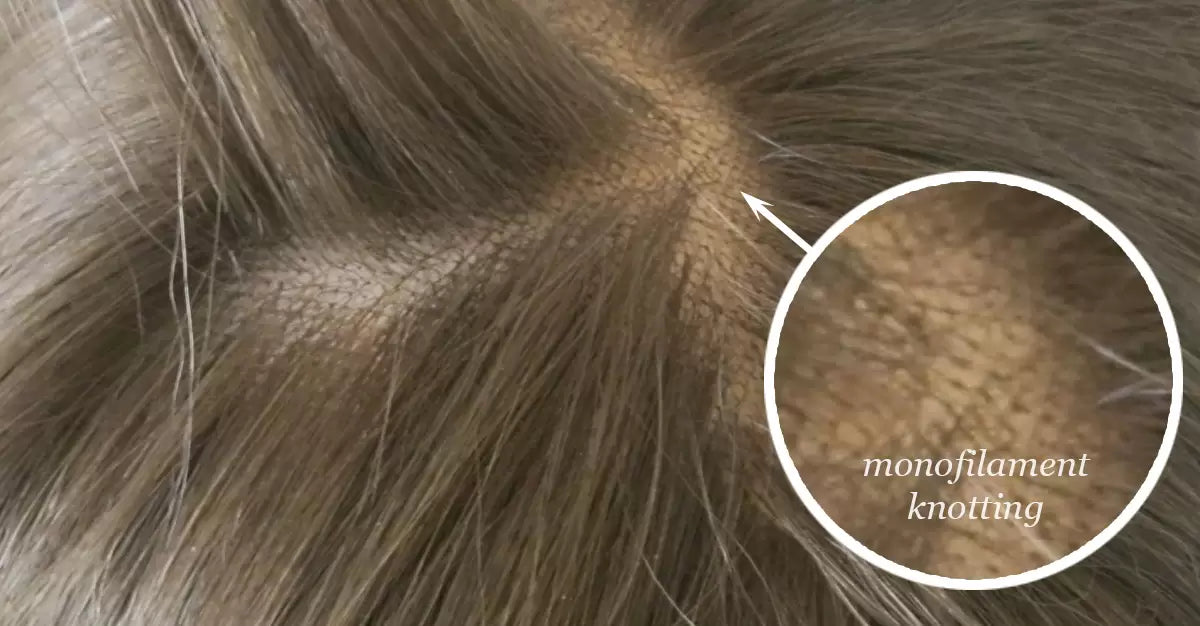What is a lace front wig? This question piques the curiosity of many. A lace front wig is a high-quality hairpiece celebrated for its realism and versatility in modern hairstyling. Expertly crafted to mimic a natural hairline, these wigs provide a seamless appearance, making them nearly indistinguishable from one's own hair. They offer the freedom to experiment with various styles, colors, and textures, or to simply give natural hair a break. Ideal for dramatic transformations, lace front wigs maintain a natural look, perfectly blending innovation with style. Let’s delve into the details of lace front wigs and learn how they can effortlessly elevate your hairstyle.

What is a lace front wig?
A lace front wig is designed to closely resemble the appearance of natural hair emerging from the scalp along the hairline. It features a sheer lace panel along the front edges, which sits flush against the forehead and follows the contours of your natural hairline. The hair strands are meticulously hand-sewn into this lace, creating the illusion of a seamless and natural hairline. The remainder of the wig cap is constructed from a sturdier material that not only helps the wig keep its shape but also enhances its longevity. This thoughtful design allows for a realistic look and durable wear.
This type of wig is also called lace frontal wig, front lace wig and lace wig. So, when shopping or researching, it's good to be aware of these terms, as some sellers may use them slightly differently.
What is the difference between lace front wigs and regular wigs?
Some of you might be new to the world of wigs and unsure about the distinctions between lace front wigs and regular wigs. Let's start with the fundamentals of both regular wigs and lace front wigs, aiming to clarify their differences comprehensively. This will help us grasp the nuances, ensuring a more informed choice when selecting the perfect wig for your needs.
Lace front wigs
-
Lace Material: The distinguishing feature of a lace front wig is its front section made of lace. This lace is a fine, sheer mesh onto which hairs are individually tied. The process is often done by hand to achieve a high level of detail, closely mimicking a natural hairline.
-
Hairline Creation: The detailed process of hand-tying each strand to the lace allows the hairline to appear exceptionally natural, mimicking the look of hair growing directly from the scalp. This method provides the flexibility to part the hair in various ways at the front, enhancing the wig's styling versatility.
-
Base Construction: Behind the lace section, the rest of the wig cap can be made from stronger, more durable materials. These sections are typically machine-sewn with wefts of hair, which is a more efficient process, balancing the wig's overall construction between durability and a natural look.
-
Customization: Due to the construction method, many lace front wigs allow for customization along the hairline, such as trimming the lace to fit the wearer's forehead shape better.
Regular wigs
-
Cap Construction: Regular wigs often use a cap that is made entirely of a stronger, more opaque fabric, without the use of lace. The hairs are either machine-sewn or hand-tied onto this cap in wefts or rows. This construction method is generally faster and less labor-intensive than the hand-tying required for lace fronts.
-
Hairline and Parting: Unlike lace front wigs, regular wigs don't closely mimic a natural hairline, which can make styles that pull hair back from the face look less natural. However, many regular wigs are pre-styled in ways that beautifully frame the face or include bangs to effectively conceal the hairline, providing appealing alternatives that enhance their overall appearance.
-
Ease of Use and Durability: Regular wigs boast simpler construction, rendering them more durable and easier to maintain. They are crafted for effortless donning and removal and can endure rigorous handling, thus proving ideal for daily wear.
-
Affordability: Generally, regular wigs are less expensive to produce and buy, since they don't require the intricate, hand-tied work of lace front wigs. This makes them an accessible option for many people just starting with wigs or those looking for a cost-effective solution.
Objectively, lace front wigs offer a more natural-looking hairline ideal for styles pulled back from the face, at the cost of delicacy and typically a higher price. Regular wigs provide ease, durability, and affordability, with some trade-off in terms of the naturalness of the hairline and styling versatility.

Why choose lace front wigs?
Having explored the key distinctions between lace front wigs and regular wigs, you now have a foundational grasp of their differences. Drawing from personal experience, I'm inclined to steer you towards considering a lace front wig. Here are compelling reasons why it could be the ideal choice for you.
-
Natural-Looking Hairline: The primary advantage of lace front wigs is their ability to mimic a natural hairline seamlessly. The transparent lace blends with the scalp, allowing the wig to appear as if hair is growing directly from your head. This feature is particularly beneficial for those with thinning hair or hair loss who wish to maintain a natural appearance.
-
Styling Versatility: Lace front wigs offer the freedom to style hair away from the face without exposing the wig cap, enabling a range of hairstyles such as ponytails and partings. This versatility facilitates effortless transitions in appearance, matching hairstyles to outfits or occasions seamlessly.
-
Comfort and Breathability: Constructed with lightweight and breathable lace material, these wigs prioritize comfort, especially in warmer climates. This feature is particularly essential for wearers who don wigs for extended durations.
-
Secure Fit: Many lace front wigs come with additional features such as adjustable straps or clips, which help to secure the wig in place. This can provide peace of mind and comfort to wearers, knowing their wig is less likely to shift or slip.
-
Customization: The frontal lace can be trimmed and adjusted to conform to the natural hairline, ensuring a personalized and snug fit. Such precision in customization sets lace front wigs apart from their regular counterparts.
-
Durability: Despite their delicate appearance, high-quality lace front wigs are quite durable when properly maintained. With the right care, they can last for a significant amount of time, making them a worthwhile investment.
-
Concealment of Hair Loss: For individuals experiencing hair loss, lace front wigs provide an effective and realistic-looking solution. They cover the front hairline in a way that other wigs cannot, offering confidence and self-assurance to the wearer.
In summary, lace front wigs offer an unmatched combination of a natural appearance, versatility in styling, and comfort. These benefits make them a preferred choice for both daily wearers and those looking to enhance their look for special occasions. Whether you’re seeking to address hair loss or simply want to experiment with your style, lace front wigs offer a versatile and convincing option.
How to wear a lace front wig
-
Preparing Your Hair
Flatten Your Hair: The flatter your hair against your head, the better the wig will fit. Use cornrows, a tight ponytail, or a wrap style for longer hair. For short hair, a wig cap can help flatten and contain your hair.
Clean Your Forehead: Remove any oils or makeup around your hairline with a gentle cleanser or alcohol wipe to ensure the wig adhesive secures properly.
-
Fitting the Wig
Test the Fit: Before applying any adhesives, place the wig on your head to ensure it fits snugly around your head without being too tight or too loose.
Trim the Lace: Once the fit is confirmed, trim the excess lace along the front. It’s crucial to leave about a 1/8-inch strip of lace to blend into your skin for a natural look.

-
Securing the Wig
Apply Adhesive: Use a brush to apply a thin layer of wig adhesive just beyond your natural hairline. You can use tape or liquid adhesive depending on your preference.
Position the Wig: Carefully place the lace part of the wig onto the adhesive area, adjusting as needed to align with your natural hairline.
-
Styling Tips
Blend for Natural Look: Once the wig is secured, blend it into your natural hairline. You might lightly apply some makeup along the hairline to create a seamless transition.
Style as Desired: Style the wig using appropriate heat settings and styling products for synthetic or human hair, depending on your wig’s material.
How to care for a lace front wig
-
Cleaning: Wash your wig every 8-10 wears. Use a sulfate-free shampoo and lukewarm water. Gently lather the hair without scrubbing, and rinse thoroughly.
-
Drying: Avoid wringing out the hair. Pat it gently with a towel and let it air dry on a wig stand to maintain its shape.
-
Storing: Keep the wig on a wig stand or mannequin head when not in use to help keep its shape and prevent tangles. Store it away from direct sunlight to avoid color fading.
Common mistakes to avoid
-
Overusing Adhesive: Using too much glue or tape can lead to build-up and might damage the lace and your skin.
-
Neglecting Wig Cap Maintenance: Replace wig caps regularly to prevent bacteria build-up, which can lead to scalp issues.
-
Sleeping in the Wig: This can cause significant wear and tear. Remove your wig before sleeping to extend its life.
Wrapping up
So, what is a lace front wig? Now we know that lace front wigs offer unparalleled versatility and a natural appearance, enhancing beauty and boosting confidence with numerous styling options. Whether you’re experimenting with new looks or seeking a reliable solution for hair loss, these wigs provide an excellent blend of realism and flexibility. Dive into the world of lace front wigs and discover how they can elevate your style and self-assurance, making every day a good hair day. Embrace this transformative accessory and unlock the potential of your personal style.




Leave a comment
All comments are moderated before being published.
This site is protected by reCAPTCHA and the Google Privacy Policy and Terms of Service apply.